- News
- Reviews
- Bikes
- Accessories
- Accessories - misc
- Computer mounts
- Bags
- Bar ends
- Bike bags & cases
- Bottle cages
- Bottles
- Cameras
- Car racks
- Child seats
- Computers
- Glasses
- GPS units
- Helmets
- Lights - front
- Lights - rear
- Lights - sets
- Locks
- Mirrors
- Mudguards
- Racks
- Pumps & CO2 inflators
- Puncture kits
- Reflectives
- Smart watches
- Stands and racks
- Trailers
- Clothing
- Components
- Bar tape & grips
- Bottom brackets
- Brake & gear cables
- Brake & STI levers
- Brake pads & spares
- Brakes
- Cassettes & freewheels
- Chains
- Chainsets & chainrings
- Derailleurs - front
- Derailleurs - rear
- Forks
- Gear levers & shifters
- Groupsets
- Handlebars & extensions
- Headsets
- Hubs
- Inner tubes
- Pedals
- Quick releases & skewers
- Saddles
- Seatposts
- Stems
- Wheels
- Tyres
- Health, fitness and nutrition
- Tools and workshop
- Miscellaneous
- Cross country mountain bikes
- Tubeless valves
- Buyers Guides
- Features
- Forum
- Recommends
- Podcast
£2,799.00
VERDICT:
Very good cyclocross/gravel bike with plenty of versatility, although the ride is on the firm side for an off-roader
Weight:
9,020g
Contact:
At road.cc every product is thoroughly tested for as long as it takes to get a proper insight into how well it works. Our reviewers are experienced cyclists that we trust to be objective. While we strive to ensure that opinions expressed are backed up by facts, reviews are by their nature an informed opinion, not a definitive verdict. We don't intentionally try to break anything (except locks) but we do try to look for weak points in any design. The overall score is not just an average of the other scores: it reflects both a product's function and value – with value determined by how a product compares with items of similar spec, quality, and price.
What the road.cc scores meanGood scores are more common than bad, because fortunately good products are more common than bad.
- Exceptional
- Excellent
- Very Good
- Good
- Quite good
- Average
- Not so good
- Poor
- Bad
- Appalling
The Niner RLT 9 is a very good cyclocross/gravel bike with plenty of versatility, although the ride is on the firm side for something designed to go off road.

Why might you want to buy the Niner RLT?
Versatile. That's the single word that best sums up the Niner RLT.
Niner call the RLT 9 (RLT stands for Road Less Traveled) a 29er, a monster cross machine, an all-road mountain bike, and a gravel grinder. Those various categories cover quite a lot of ground and you could argue the toss all day long about which is the best description, but who cares? I'd rather just get out and ride, so that's what I did.
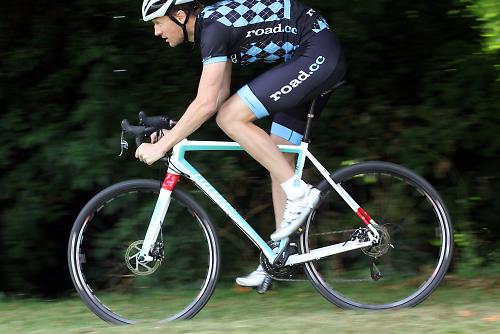
I rode the RLT 9 over a whole variety of different surfaces – chalky, gravelly roads, forest tracks, muddy bridleways, singletrack through the woods, tarmac, all sorts. Of them all, I'd say the RLT 9 handled gravel roads the best; stuff that's firm but not smooth, if you know what I mean. I have plenty of that kind of road close to me and the RLT 9 was a sure-footed companion for exploring it and getting across connecting sections of tarmac reasonably quickly.
The RLT 9 is built around an alloy frame with Niner's own carbon fork plugged in up front. It comes with Stan's ZTR cyclocross wheels and semi-slick 35mm tyres, a SRAM Force groupset with cyclocross gear ratios, and Avid BB7 cable operated disc brakes (more on the spec later on). I found this to be really well-suited to quickly skipping over solid but rough roads.
Niner specialise in 29er mountain bikes; the RLT 9 is the only drop-handlebar model in the range. They say that it's built to a 'fire road geometry'. We have the 56cm frame in on test which comes with a 560mm seat tube, a 565mm top tube, and a 165mm head tube. The reach (the horizontal distance from the centre of the bottom bracket to the top of the head tube) is 385mm and the stack (the vertical distance between those two points) is 589mm.

Those numbers are fairly similar to ones you might find on a 56cm road bike but the head tube angle is slack (71.5°) and the chainstays are long (430mm) resulting in quite a lengthy wheelbase.
Numbers, schnumbers. All that really matters is how the bike rides and I found the RLT 9 to be pretty stable at speed, holding its line well when stones and little dips in the surface are doing their best to unsettle you and ping you off to the side. With the headset spacers removed from underneath the stem, you can get yourself into an aggressive ride position here, especially when you're down on the handlebar's drops, and really churn along sweeping tracks without things feeling twitchy when the road gets lumpy or jagged. That's when the RLT 9 is at its best – on fast, open, hard-packed roads when you can put the hammer down and build up your speed.
That's not to say that the RLT 9 can't handle the more technical stuff. It can. It encourages you to head off on trails where you really shouldn't go on a drop-barred bike, just for a laugh. Rides that were planned to be one hour blasts frequently became one-and-a-half hours, two hours, two-and-a-half: I'll just go and see what's up here; I wonder whether I can ride down there; oh, now I'm lost. Yet again.
The RLT 9 is quick handling enough to sling hard through the twists and turns and the confidence you get from the Avid BB7 brakes means you might find yourself heading down muddy descents at crazy speeds. It's not quite mountain bike-fast in those situations, but it's a lot of fun.
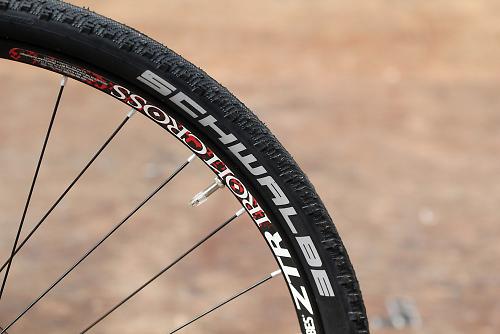
You wouldn't want to go too muddy or you'll find the limitations of the Schwalbe Sammy Slick tyres. They're semi-slicks (they should be called them Schwalbe Sammy Semi Slicks for maximum sibilant effect) with knobbly shoulders and a far lower profile central tread – ideal for keeping you rubber-side down on dryish and firmish roads and tracks, but not so good at biting in to the gloop when things get softer. They're more rollers than grippers. Of course, if you do fancy getting stuck into some serious mud riding – and why the hell wouldn't you want to make the most of the bike's full potential? – tyres are an easy swap.
Weighing in at 9.02kg (19.8lb) on the road.cc Scales of Truth, the RLT 9 is a reasonable weight rather than superlight for a £2,800 bike, but it cranks up to speed readily. It's not startlingly quick off the mark but it's swift footed enough, and it handles the climbs with confidence, maybe even a bit of a swagger. The climbing ability is partly down to the SRAM Force 22 drivetrain. You get a 46/36-tooth chainset – nothing unusual in that – matched up to a wide-ranging 11-32-tooth SRAM WiFLi cassette. Match up the 36-tooth inner ring with the 32-tooth inner sprocket and you can winch yourself up pretty much anything short of a cliff. You're not going to go anywhere particularly fast in that combo, mind, but you will get there without having to resort to the walk of shame.

At the other end of the scale, the biggest gear the RLT 9 offers is 46 x 11, which is almost exactly the same as the 50 x 12 that you get on a lot of road bikes equipped with compact chainsets. That allows you to keep pedalling well beyond 30mph – beyond 40mph if you're happy spinning your legs at about 120rpm. That's likely to be plenty, especially if you're on rutted, gravelly roads. If not, well, you're just going to have to take a rest until you slow down a bit.
That gearing is suitable for road use. Indeed, the RLT 9 comes with eyelets for the easy fixing of mudguards too, the front ones covered by little rubber bungs so that gunk doesn't get in when you're not using them and, as mentioned above, the geometry is fairly aggressive so you don't feel like you're taking the wind full on the chest when you want to ride fast on the black top.
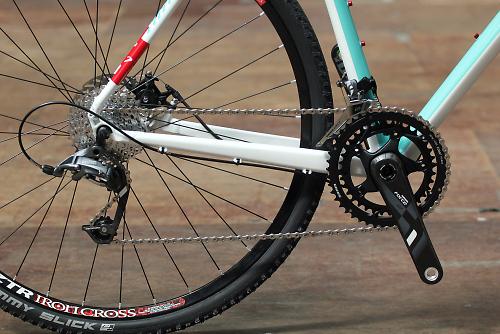
You'd want to swap the tyres, though. The Schwalbe Sammy Slicks run okay on the road but something slimmer, slicker and lighter would add speed if you were going to spend a lot of time on tarmac. Switching between tyres would be a pain in the butt if you were doing it on a regular basis. Having a set of road wheels and a set of off road wheels fitted with the relevant tyres would obviously be a whole lot easier, and the RLT 9 uses regular quick releases so it'd be no biggie. The fork has recessed, forward-facing dropso swapping the wheel takes a few seconds longer than normal.
What might make you think twice?
The RLT 9 is one of the stiffer gravel/cyclocross bikes out there. Let's be honest, it's pretty darn rigid although not quite harsh.
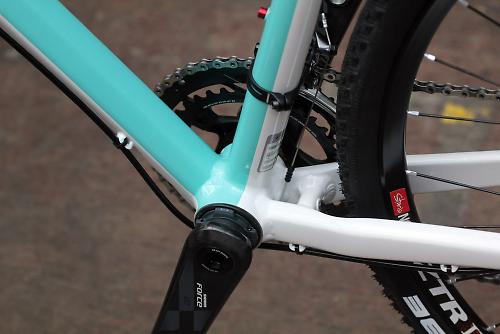
The carbon fork, which comes with a huge crown and a 1 1/2in lower bearing, doesn't do a great deal to filter out vibration from the road and the same is true of the aluminium handlebar and stem. Bearing in mind that this bike is designed for riding over gravel roads that by their very nature aren't very smooth, that means your wrists have to cope with quite a lot of buzz.
The slim 27.2mm carbon seatpost and Niner's own chromoly-railed saddle are both decent quality (I got on really well with the shape of the saddle) but they do have their work cut out coping with quite a hard back end.

I have to say, though, that tyre choice and pressure is going to make a massive difference to your level of comfort. Fit something with a big air chamber and it'll make all the difference.
Plus, the amount of time you're likely to stay on the bike is going to be relevant here too. If you're going to blast around a cyclocross course for an hour, that frame stiffness really isn't going to bother you. If you're riding fireroad all day long, you might start wishing for a bit more fore/aft movement in the fork and a bit more give in the rear triangle.
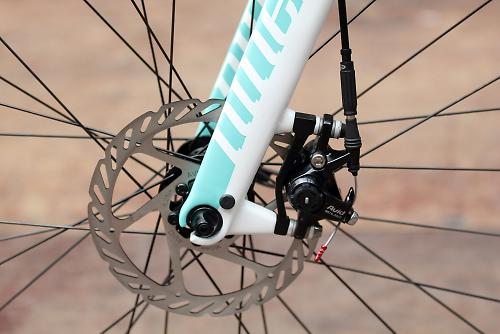
The other potential issue is the wheel/tyre combo. The Stan's ZTR Iron Cross tubeless ready rims have a maximum tyre pressure of 45psi. The Schwalbe Sammy Slick tyres have a minimum pressure of 50psi. So how does that work? You can't keep both Stan's and Schwalbe happy at the same time.
We contacted Niner about this and they said, 'You can only inflate any tyre to the lowest maximum psi in the system. In this system, the lowest max psi is 45psi. Hence, 45psi is the max pressure this system will handle. I have heard that 55psi is okay on these wheels with a tube.'
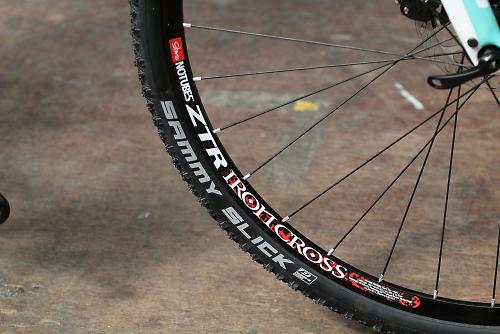
Okay. We used the tyres with tubes and I ran them at 50psi most of the time (you want that in bar, do you? It's 3.4). What can I tell you? The sky didn't fall in and, more to the point, the tyres stayed on the rims although we hear that other people have not been so lucky with a tubeless setup, the tyres coming off the rims at over 45psi so they've had to swap the tyres.
The frame and fork
As we've already mentioned, the RLT 9's frame is made from aluminium – hydroformed aluminium – and it's an attractive-looking piece of work.
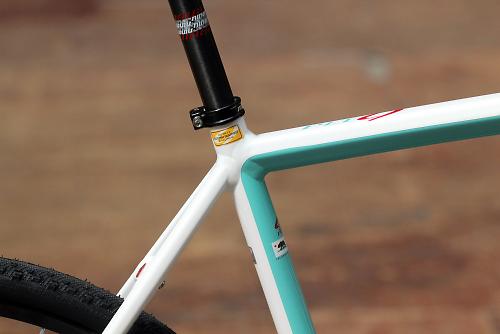
The down tube is a chunky hexagon profile up top, tapering down along its length, and the top tube is similar, bowing very slightly from front to back. The meatiest element by far is the head tube that houses a 1 1/8in bearing at the top and a big old 1 1/2in number at the bottom for increased stiffness. That's something that you see on many, many bikes these days, particularly higher end bikes that are designed for speed and efficiency.
The bottom bracket is oversized PF30 standard and you get solid-looking stays out back. The idea of the slim 27.2mm seatpost is to add a little flex and comfort to the ride although, as mentioned above, the frame sits towards the stiffer end of the spectrum.
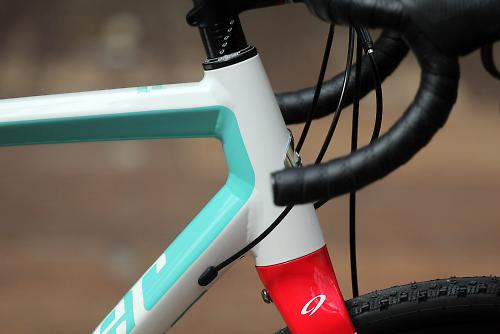
The fork is Niner's own full-carbon model and it emphasises rigidity over fore/aft movement. Niner say that all of their forks and frames are tested to mountain bike safety standards. Well, frames and forks never fail during our relatively brief test periods (we tend to have each bike for around four weeks) but the RLT 9 certainly looks burly enough to put up with a lot of abuse.
The RLT 9 comes with internal gear cable routing and it has ports for a Di2 electronic shift system. The rear mech cable exits the frame underneath the bottom bracket and takes the final leg of its journey in the fresh air, zip-tied to eyelets underneath the driveside chainstay (it looks neater than it sounds).

The brake cables are external, the rear one running towards the underside of the down tube, beneath the bottom bracket and along the chainstay. There are no cables along the top tube so there's nothing to get in the way if you shoulder the bike in a cyclocross race.
The RLT 9 is made with proprietary forged dropouts that are designed to reduce weight. As mentioned earlier, you get eyelets for fitting a mudguard to those dropouts and mudguard mounts up front too.
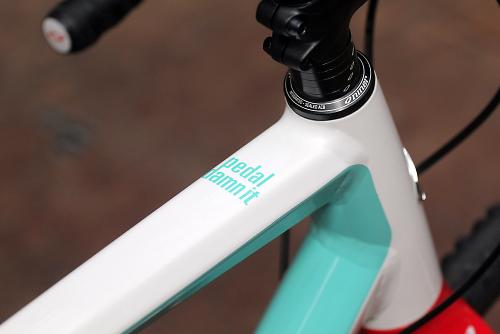
Most people seem to like the Niner's paint job and I'm in tune with popular opinion here. I think it looks pretty cool without going over the top, with neat little touches like a Niner logo on the underside of the down tube and the helpful advice to 'Pedal damn it' on the top tube to keep you on track when the going gets tough. There are no chips in the paint to speak of after a month's riding.
The spec
Our RLT 9 came fully built up with a SRAM Force 22 groupset with a 46/36-tooth chainset and an 11-32-tooth cassette. This all worked perfectly throughout testing: nothing to see here, move along! You're either into SRAM's Double Tap shift system of you're not, the same as applies to the equivalents from Shimano and Campagnolo.
The brakes are Avid's well regarded BB7 Road S cable-operated discs. They're easy to set up and adjust, a dial on each side allowing you to control the position of each pad independently, and they provide plenty of stopping power in all conditions. If you've not used disc brakes before, these are a good place to start because they're so user-friendly.

The wheels are Stan's cyclocross ZTR Iron Cross 700c rims laced to 3.30 135mm hubs, and the tyres are Schwalbe Sammy Slicks in a 1.35in (35mm) width. You could use wider 29er rims and tyres in there for tackling more extreme surfaces. You can fit tyres up to 29 x 1.75in (depending on the brand) so the 1.35in Sammy Slicks had acres of clearance.
The cockpit components are Niner's own: an alloy handlebar and stem, a carbon-fibre seatpost and a chromoly-railed saddle.
The RLT 9 is priced at £2,799 in this complete build. You have to say that the price is a bit spicy for a bike with an alloy frame and a second tier groupset.
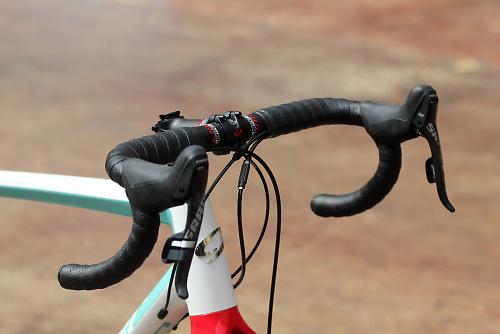
The bike is also available in a Shimano 105 complete build for £1,899. This version gets 105 shifters and a 105 rear mech, although the front mech is next-level-down Tiagra, as is the 12-30-tooth cassette, and the chainset is a SRAM S350 (46/36-tooth). The wheels on this model are Niner's own while the brakes are Avid BB5, the BB7's little brother. A frameset (including the Niner carbon fork) is £999.
Conclusion
The RLT 9 is fast and a lot of fun, especially on firm but not necessarily smooth surfaces. The reservation I'd have is that it provides quite a rigid ride. That's not an issue on shorter rides but it might make you think twice if you want something for all-day epics.
Verdict
Very good cyclocross/gravel bike with plenty of versatility, although the ride is on the firm side for an off-roader
road.cc test report
Make and model: Niner RLT 9
Size tested: 56, fresh mint
About the bike
State the frame and fork material and method of construction. List the components used to build up the bike.
FRAME: RLT 9, hydroformed aluminium
FORK: NINER Full Carbon Fork, Q/R 9MM
WHEELS: NOTUBES 3.30/ZTR IRON CROSS, Q/R 9MM FRONT, Q/R 135MM Rear
TYRES: SCHWALBE Sammy Slick RG, Folding, 700 X 35
BRAKES AND ROTORS: SRAM BB7 R, 160/140MM G2 Rotors
BRAKE LEVERS: SRAM Force 22
REAR SHIFTER: SRAM Force 11sp
FRONT SHIFTER SRAM Force
REAR DERAILLEUR: SRAM Force 11sp WIFLI
FRONT DERAILLEUR: SRAM Force YAW w/ Chain Spotter, 34.9 Clamp
CASSETTE: SRAM PG 1170 11sp 11-32T
CHAIN: SRAM PC 1170
CRANK SET: SRAM Force 22 YAW PF30 46/36T
BOTTOM BRACKET: SRAM PF30
SADDLE: Niner Custom with Cr-Mo Rails, Niner Graphic
SEAT POST: NINER Carbon Seat Post, 400MM, Red Niner Graphic
HANDLEBAR: NINER Drop Top Alloy, Red Niner Graphic
STEM: NINER Alloy Stem, Red Niner Graphic
GRIPS: NINER Bar Tape
Tell us what the bike is for, and who it's aimed at. What do the manufacturers say about it? How does that compare to your own feelings about the bike?
Well, there's a question. Niner variously describe the RLT 9 as a 29er, a monster cross machine, an all-road mountain bike, and a gravel grinder. Those various categories cover quite a lot of ground and you could argue the toss all day long about which is the best description, but who cares? I'd rather just get out and ride, so that's what I did.
Frame and fork
Overall rating for frame and fork
7/10
Riding the bike
Was there any toe-clip overlap with the front wheel? If so, was it a problem?
A tiny amount. It didn't bother me.
Rate the bike for efficiency of power transfer:
8/10
Rate the bike for acceleration:
7/10
Rate the bike for sprinting:
7/10
Rate the bike for high speed stability:
8/10
Rate the bike for cruising speed stability:
8/10
Rate the bike for low speed stability:
8/10
Rate the bike for flat cornering:
8/10
Rate the bike for cornering on descents:
8/10
Rate the bike for climbing:
7/10
The drivetrain
Rate the drivetrain for performance:
8/10
Rate the drivetrain for durability:
8/10
Rate the drivetrain for weight:
8/10
Rate the drivetrain for value:
7/10
Wheels and tyres
Rate the wheels and tyres for performance:
8/10
Rate the wheels and tyres for durability:
7/10
Rate the wheels and tyres for weight:
7/10
Rate the wheels and tyres for value:
7/10
Controls
Rate the controls for performance:
8/10
Rate the controls for durability:
7/10
Rate the controls for weight:
8/10
Rate the controls for comfort:
8/10
Rate the controls for value:
7/10
Your summary
Did you enjoy riding the bike? Yes.
Would you consider buying the bike? Possibly, if I wanted something for blasting gravel roads and the like.
Would you recommend the bike to a friend? As above.
Rate the bike overall for performance:
8/10
Rate the bike overall for value:
6/10
Anything further to say about the bike in conclusion?
I had a whole lot of fun on this bike, exploring and trying out new roads, bridleways and trails. I enjoyed it loads. My reservations would be that it's a firm ride and that might be an issue if you want to spend long hours in the saddle, and the price could be more competitive.
About the tester
Age: 43 Height: 190cm Weight: 75kg
I usually ride: My best bike is:
I've been riding for: Over 20 years I ride: Most days I would class myself as: Expert
I regularly do the following types of riding: commuting, club rides, sportives, general fitness riding,
Mat has been in cycling media since 1996, on titles including BikeRadar, Total Bike, Total Mountain Bike, What Mountain Bike and Mountain Biking UK, and he has been editor of 220 Triathlon and Cycling Plus. Mat has been road.cc technical editor for over a decade, testing bikes, fettling the latest kit, and trying out the most up-to-the-minute clothing. He has won his category in Ironman UK 70.3 and finished on the podium in both marathons he has run. Mat is a Cambridge graduate who did a post-grad in magazine journalism, and he is a winner of the Cycling Media Award for Specialist Online Writer. Now over 50, he's riding road and gravel bikes most days for fun and fitness rather than training for competitions.
Latest Comments
- Bigfoz 2 sec ago
"her vision was impaired" by method of not looking...
- mdavidford 23 min 13 sec ago
£10.0000 seems like a bargain to me, even for just the saddle, never mind the rest of it. Not sure anyone's pricing bikes in hundredths of a penny...
- stonojnr 35 min 15 sec ago
shame the old fuel line valve isnt so accessible on modern bikes, I doubt theyd have any clue what youd done to their bike if you turned that....
- cmedred 2 hours 23 min ago
Lost control of his car doing 40 mph through a 60 mph corner? Sort of begs for some questions as to how Wan obtained a license to drive in the...
- quiff 2 hours 31 min ago
I do understand that policing resources are limited and need to be prioritised, but do we really have to wait until a KSI before they take action?...
- andystow 3 hours 10 min ago
Still no mention of a driver....
- Sredlums 4 hours 51 min ago
Yes, there's a pedal on one side counteracting what you do on the other, so you'd say that evens each other out....
- brooksby 5 hours 52 min ago
Electric car smashed up with 'big pole' in protest against Elon Musk (Bristol Post)...
- chrisonabike 5 hours 56 min ago
Just harness it. In European countries selfish and arrogant people are demanding better cycling facilities (for their convenience) and probably...
- chrisonabike 6 hours 51 sec ago
What's perhaps notable is - once I thought about it - I found that every single bike trip around Edinburgh would encounter some kind of "works". ...





































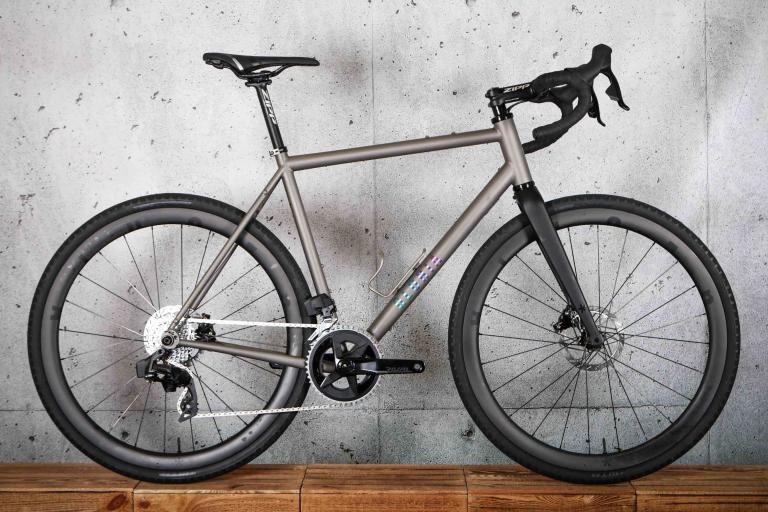
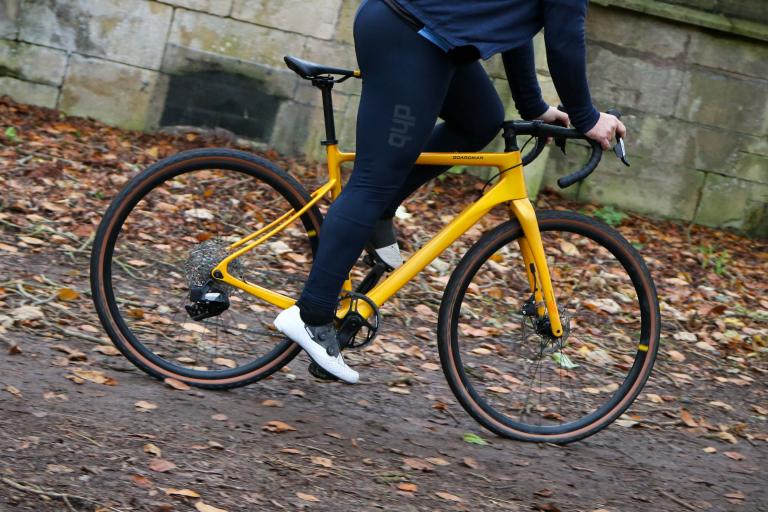
Add new comment
8 comments
The price has a lot to do with trend spotting. Not many 29er crosses exist off the peg but a lot are being built up at the moment by bespoke fabricators or privateer racers.
It's still under specced though.
The manufacturer suggested running at 45psi though, since this is the max for the rims.
But it really seems that Niner have bummed on the choice of tyres and rims, selecting items that don't really seem compatible in terms of maximum, let alone optimal, pressure.
The reviewer can't recommend doing something the manufacturer doesn't recommend. I don't think anyone's claiming to be an expert, perhaps just offering some real-world opinions.
I have a set of these rims, built up into a disc road/cyclo bike with 28/32. On the road I run Conti GP4000S, with tubes, at 90+ PSI, with no hint of trouble - no spoke bed damage, and certainly no tyre movement, despite being inclined to pop off of things when the opportunity presents.
You can do pretty much what you want - you just have to be willing to experiment and use a little common sense about the way you ride.
Love the colour scheme. Price on the other hand is silly, esp compared to Boardman CX models & others too I'm sure...
My big issue with this one would be the price - you could quite happily get a similarly specced cross bike (if a kilo or so heavier) for a third of that, and from the sounds of it a comfier ride too. For nigh on three grand, I'd be wanting to spend it on a Ti frame and hydraulic brakes, or a tough ass carbon frame if I'm going like the proverbial off a shovel.
Maybe he usually rides a hovercraft?
You ran the tyres at 50psi and found it a bit harsh off-road?